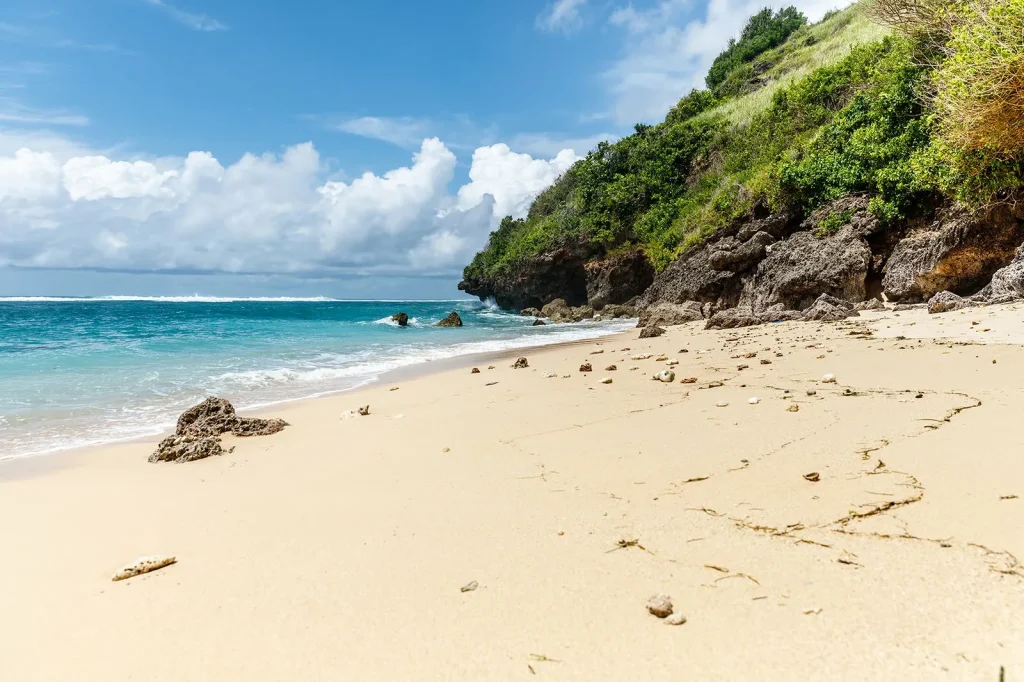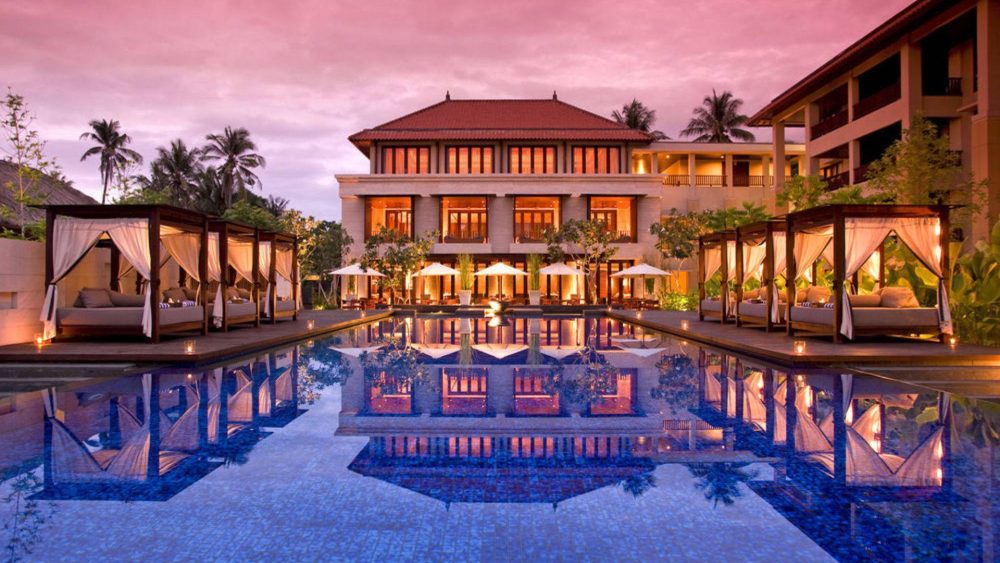Bali is not just an island, but a world where every coastline is unique. There are surf beaches with perfect waves, secluded coves for a quiet holiday and luxurious sandy strips lined with beach clubs. The variety of scenery is amazing: the white sand of Uluwatu, the black volcanic beaches in the north, the coral shoals of Sanur.

The beautiful beaches of Bali are not only popular tourist locations, but also hidden corners that only the locals know about. This is where you can enjoy the secluded atmosphere, clean coastline and incredible scenery while staying away from the noise of the crowds. This article is a complete guide with a detailed map of the locations of these paradises.
Bali’s best beaches for an unforgettable holiday
The beaches in Bali vary in atmosphere and natural features. Some are perfect for meditating at dawn, while others are perfect for partying until the morning. In order to find these beautiful Bali beaches, it is important to determine the purpose of your holiday.

The coasts can be categorised:
- sandy beaches with easy access to the water, ideal for family holidays;
- Coral coves that attract divers and snorkellers;
- A high-wave coastline that attracts surfers from all over the world.
Each coastline on the island offers unique vistas. Let’s take a look at 10 places that impress with their natural scenery, atmosphere and infrastructure:
Top 10 beautiful beaches in Bali:
- Kuta Beach
- Seminyak Beach
- Jimbaran Beach
- Padang Padang Beach
- Sanur Beach
- Pemuteran Beach
- Melasta Beach
- Bingin Beach
- Balangan Beach
- Nyang Nyang Beach
We’ll talk more about each of these amazing coasts in the article below.
Where to find the most beautiful beaches in Bali
The island is renowned for its variety of beaches, from crowded white sand resort areas to wild coves hidden among the cliffs. Surfing, swimming, secluded holidays or gastronomic experiences are all available, depending on preference.
The most picturesque beaches are concentrated in the southern and eastern parts of the island. The west coast is famous for its powerful waves that attract surfers. The northern direction is suitable for diving and snorkelling.
The best regions with beautiful beaches in Bali:

- for surfing – the west coast, where the big waves form. Particularly popular beaches include Kuta, Padang Padang, and Balangan. Both waves for beginners and serious reels for pros are found here;
- for swimming – calm bays of Sanur, Pemuteran, Melasti, protected from high waves by coral reefs and natural barriers. The water here is clean and transparent, the bottom is sandy and coral;
- for luxury holidays – Seminyak coast, where expensive resorts, beach clubs with swimming pools and restaurants with panoramic ocean views are concentrated;
- For romance, there’s Jimbaran with spectacular sunsets and restaurants right on the sand serving the freshest seafood.
Each region offers extraordinary natural locations, so when choosing a place, it is important to consider the purpose of the holiday, the level of waves and the features of the infrastructure.
Bathing beaches – where the water is clear and calm
Not all of Bali’s coastline is suitable for comfortable swimming. Some places have strong currents, rocky bottoms or high surf. For a relaxing holiday without waves, it is worth choosing sheltered bays. Such as:
- Sanur is a calm lagoon with a sandy entrance to the water. There are almost no waves here due to the natural barrier of coral reefs. It is ideal for families with children and the elderly. There are cafes, boat hire and beach clubs along the coast.
- Pemuteran is one of the cleanest and most picturesque spots in Bali. The shoreline is covered with fine golden sand and the water is smooth with no sharp depths. The famous artificial reef Biorock is located here, where snorkelling and diving lovers come.
- Melasti is a secret corner in the south of the island with turquoise water and white sand. For a long time this beach was closed to tourists, but now there is a road right through the rocks. The water here is incredibly clear, and the descent into the ocean is soft and gentle.
Surfing beaches – the best waves
The island of Bali is the surfing capital of the world, with locations for beginners and professionals. The most popular wave zones are located on the west coast of the island. Let’s consider the most popular coasts for extreme surfing:
- Kuta is the ideal place for your first attempts to conquer a wave. The gentle bottom relief makes surfing comfortable even for beginners. There are surf schools with experienced instructors on the coast.
- Padang Padang is an iconic spot for experienced surfers. Waves here can reach 3-4 metres, creating powerful tunnels. At low tide, picturesque lagoons with coral reefs open up.
- Balangan is an atmospheric place to ride. It has great wave lengths and is close to surf camps and cosy cafes. Suitable for intermediate to advanced riders.
When choosing a beach, it is important to consider the season, wind direction and level of fitness.
Incredible beaches in Bali that few people know about
In addition to popular locations, the island has amazing coastlines hidden from the tourist traffic. These are real natural gems with white sand, azure water and minimal infrastructure.
Melasti is a secret beach among the cliffs
It is located in the southern part of the island, surrounded by high limestone cliffs. For a long time it remained closed to the public. Today, a new scenic road leads here, which is built right through the cliffs. Important differences:
- the water is clear, no waves or currents;
- The sand is snow-white, soft, no rubbish or seaweed;
- one of the best places for photo shoots thanks to the natural arches and grottos.
Bingin is a surfer’s haven without the crowds of tourists
A small secluded cove with a soft sandy bottom and an incredible boho atmosphere. Characteristic features of the beach:
- Medium-high waves – great for surfing;
- The cafe and bungalows are located right on the cliffs overlooking the ocean;
- one of the best beaches for sunsets in Bali.
Nyang Nyang is a long wild beach
This coastline is often overlooked by tourists. The only way to get here is on foot, through the jungle. This makes the journey difficult and time-consuming. Many people prefer more accessible places, unaware of the amazing sight that awaits them on this secluded coastline. Distinctive features of the beach:
- minimum people, maximum nature;
- the water is azure, the sand is light gold;
- Ideal for trekkers looking for solitude.
These beaches allow you to experience Bali from a different perspective – without the crowds, tourist umbrellas and noise of the city.
Conclusion
 Bali’s beautiful beaches are amazingly diverse. Surfing, luxury resorts, secluded corners – everyone will find a place to their liking. Here you can meditate at dawn, dive into the underwater world or enjoy gastronomic masterpieces right by the ocean. Bali is not just a journey, it is an adventure that begins with the first step onto the soft sand. Discover your beach paradise now!
Bali’s beautiful beaches are amazingly diverse. Surfing, luxury resorts, secluded corners – everyone will find a place to their liking. Here you can meditate at dawn, dive into the underwater world or enjoy gastronomic masterpieces right by the ocean. Bali is not just a journey, it is an adventure that begins with the first step onto the soft sand. Discover your beach paradise now!
 en
en  ar
ar  de
de  es
es  fr
fr  nl
nl  ru
ru  hi
hi  it
it  pt
pt  el
el 











